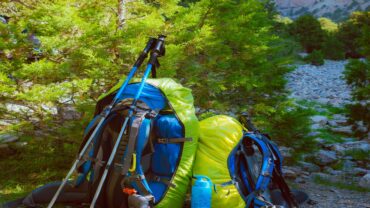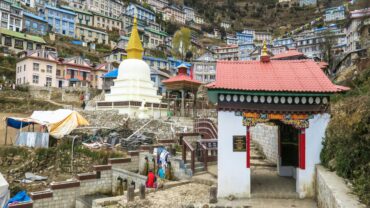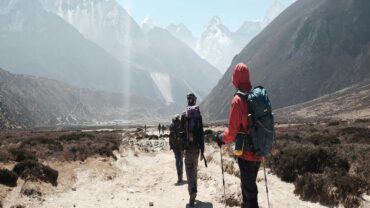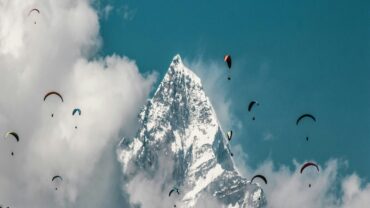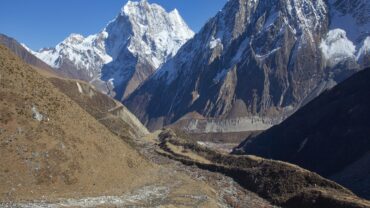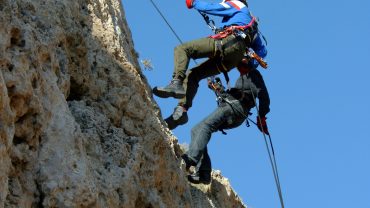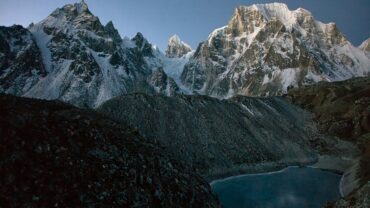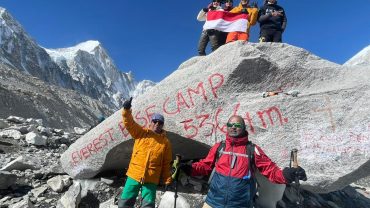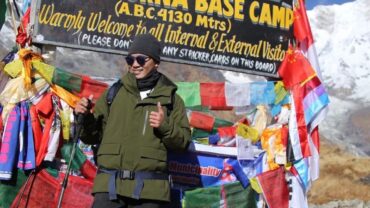- Annapurna Base Camp Trek
- 05 May 2024
Annapurna Base Camp Trek A Journey to the Roof of the World
Trek to the Roof of the World on the Annapurna Base Camp Trek and experience an incredible adventure. This journey, which offers a glimpse into the spectacular splendor of the Himalayas, is majestic and enthralling. It passes through difficult terrain, dense forests, and tranquil vistas. This walk, which spans more than 160 kilometers, is an incredible experience that will leave you in awe of the wonders of nature. As you trek to the Annapurna Base Camp, you’ll encounter snow-capped mountains, ancient villages, and vibrant flora and fauna. The trail leads you through remote villages where you can experience the warm hospitality of the locals and immerse yourself in their rich culture. Each step brings you closer to the Annapurna Sanctuary, a hidden gem nestled at the base of towering mountains, including Mt. Annapurna, the tenth highest mountain in the world. The Annapurna Base Camp Trek offers a range of breathtaking vistas, from sunrise views over snow-covered peaks to panoramic landscapes dotted with terraced fields and quaint villages. If you’re an adventure enthusiast seeking an unforgettable experience, this trek should be at the top of your bucket list. So lace up your hiking boots, pack your camera, and get ready to embark on a journey of a lifetime to the mesmerizing Annapurna Base Camp. Overview of the Annapurna region The Annapurna region, located in central Nepal, is one of the most popular trekking destinations in the world. It is named after Mount Annapurna, the tenth highest mountain in the world, with an elevation of 8,091 meters. The region is renowned for its stunning natural beauty, diverse landscapes, and rich cultural heritage. The Annapurna Base Camp Trek, also known as the Annapurna Sanctuary Trek, takes you deep into the heart of the Annapurna region. The trek begins in Nayapul, a small village near the city of Pokhara, and follows a well-established trail through lush forests, terraced fields, and traditional villages. As you ascend, the scenery becomes more dramatic, with snow-capped peaks, cascading waterfalls, and deep gorges. Trekking routes and itineraries There are multiple trekking routes and itineraries available for the Annapurna Base Camp Trek, catering to different preferences and fitness levels. The most popular route is the classic Annapurna Base Camp Trek, which takes around 10 to 14 days to complete. This route offers a perfect balance of natural beauty, cultural experiences, and manageable daily distances. The trek typically starts in Nayapul and follows a well-marked trail through Tikhedhunga, Ghorepani, Tadapani, Chhomrong, and Deurali before reaching Annapurna Base Camp. Along the way, you’ll be rewarded with breathtaking views of mountains such as Machapuchare (Fishtail), Dhaulagiri, and of course, Annapurna. If you have more time and want to explore the region in depth, you can opt for the Annapurna Circuit Trek. This trek circumnavigates the entire Annapurna massif and takes approximately 18 to 21 days to complete. It offers a more challenging and remote experience, passing through high mountain passes, remote villages, and diverse landscapes. Physical preparation for the trek The Annapurna Base Camp Trek is a moderate to strenuous trek, requiring a reasonable level of fitness and endurance. It is essential to prepare your body physically before embarking on this adventure. Regular exercise, especially cardiovascular activities like hiking, running, or cycling, can help improve your stamina and prepare you for the physical demands of the trek. In addition to cardiovascular exercise, it is important to strengthen your leg muscles, as you will be walking for several hours each day. Exercises such as squats, lunges, and calf raises can help build strength in your lower body. It is also recommended to do some core exercises to improve balance and stability. It is advisable to start your physical preparation at least 2-3 months before the trek, gradually increasing the intensity and duration of your workouts. This will not only improve your physical fitness but also give your body time to adapt to the altitude and reduce the risk of altitude sickness. Required permits and documents Before undertaking the Annapurna Base Camp Trek, it is important to obtain the necessary permits and documents. As a foreigner, you will need to obtain the Annapurna Conservation Area Permit (ACAP) and the Trekker’s Information Management System (TIMS) card. The ACAP is an entry permit that allows you to trek in the Annapurna Conservation Area. It can be obtained from the Nepal Tourism Board office in Kathmandu or Pokhara, as well as from various authorized trekking agencies. The ACAP costs around USD 30 per person. The TIMS card is a trekking registration card that provides information about trekkers and their trekking routes. It can be obtained from the Nepal Tourism Board office in Kathmandu or Pokhara or from registered trekking agencies. The TIMS card costs around USD 20 per person for individual trekkers and USD 10 per person for trekkers going through a registered trekking agency. It is also important to carry a valid passport with at least 6 months of validity remaining and a few passport-sized photographs for the permit application process. Make sure to keep these documents safe throughout your trek, as you may be required to show them at various checkpoints along the trail. Accommodation and food options along the trek During the Annapurna Base Camp Trek, you will find a range of accommodation options to suit different budgets and preferences. Along the trail, there are teahouses or guesthouses that offer basic but comfortable lodging facilities. These teahouses typically provide rooms with twin beds or bunk beds, shared bathrooms, and communal dining areas. Staying in teahouses is a unique experience that allows you to immerse yourself in the local culture and interact with fellow trekkers. The teahouse owners are known for their warm hospitality and delicious home-cooked meals. You can expect to enjoy traditional Nepali dishes like dal bhat (lentil soup with rice), momo (dumplings), and various vegetable curries. It is advisable to carry some cash with you during the trek, as most teahouses do not accept credit cards. The cost of accommodation and food
- Base Camp Trip
- 15 Mar 2024
Solo Trekking vs. Group Trekking: A Detailed Comparison
Trekking, whether solo or in a group, offers unparalleled opportunities for adventure, self-discovery, and connection with nature. However, each approach comes with its own set of advantages and disadvantages. Deciding between solo trekking and group trekking depends on various factors, including personal preferences, experience level, safety considerations, and the nature of the trek itself. Let’s explore the pros and cons of each. Embarking on a trek is more than just a physical journey; it’s an odyssey of self-discovery, a communion with nature, and a test of endurance. Whether you choose to trek solo or with a group, each option presents its own set of advantages and challenges. In this comprehensive analysis, we’ll delve into the intricacies of solo trekking and group trekking, exploring their nuanced pros and cons to help you make an informed decision for your next wilderness adventure. Solo Trekking: Pros: Freedom and Flexibility: Solo trekking offers the ultimate freedom to chart your own course. With no one else to consider, you can set your pace, choose your route, and adjust your schedule as you see fit. Whether you want to linger at a scenic overlook or tackle an extra summit, the decision is entirely yours, empowering you to embrace the spontaneity of the wilderness. Self-Discovery: Trekking alone provides a unique opportunity for introspection and self-discovery. As you navigate rugged terrain and confront challenges solo, you’ll gain valuable insights into your strengths, weaknesses, and innermost thoughts. Solitude fosters clarity of mind, allowing you to reconnect with yourself and gain a deeper understanding of your place in the world. Challenge and Independence: Solo trekking is not for the faint of heart; it requires courage, resilience, and self-reliance. Every step you take is a testament to your independence and resourcefulness, as you navigate unfamiliar terrain and overcome obstacles on your own. Embracing the solitude of the wilderness, you’ll discover a newfound sense of confidence and empowerment that transcends the confines of the trail. Immersion in Nature: Without the distractions of companionship, solo trekkers can fully immerse themselves in the natural world. From the whisper of the wind to the call of a distant bird, every sound becomes a symphony, every sight a masterpiece. Alone in the wilderness, you’ll develop a deep appreciation for the raw beauty and untamed wilderness that surrounds you, forging a profound connection with the earth beneath your feet. Cons: Safety Concerns: While solo trekking offers unparalleled freedom, it also comes with increased risk. Venturing alone into remote wilderness areas exposes you to a range of hazards, from sudden weather changes to encounters with wildlife. In the event of an emergency, such as an injury or illness, the absence of companions can escalate the situation, leaving you vulnerable and in need of assistance. Loneliness and Isolation: Trekking alone can be a solitary experience, especially during long stretches of trail with no one else in sight. While solitude can be rejuvenating, prolonged isolation may lead to feelings of loneliness or melancholy, particularly during quiet evenings in camp. Without the camaraderie of fellow trekkers, you may find yourself longing for human connection and companionship. Logistical Challenges: Planning and executing a solo trek requires meticulous preparation and attention to detail. From selecting appropriate gear and supplies to mapping out your route and arranging transportation, every aspect of the journey falls squarely on your shoulders. Without the support of a group, you must rely on your own skills and resources to navigate the logistical complexities of the trek. Limited Support: Without the safety net of a group, solo trekkers must be prepared to handle any challenges or emergencies that arise on the trail. Whether it’s a twisted ankle or a broken tent pole, there’s no one else to rely on for help or support. Self-sufficiency is paramount, requiring you to be prepared for any eventuality and equipped to handle whatever comes your way. Group Trekking: Pros: Safety in Numbers: Trekking in a group provides an added layer of safety and security. With multiple sets of eyes and ears watching out for each other, the risk of encountering danger is significantly reduced. In the event of an emergency, such as a medical issue or navigational error, the collective knowledge and resources of the group can be a lifesaver, ensuring prompt assistance and support. Shared Experience: One of the greatest joys of group trekking is the camaraderie forged through shared experience. Whether you’re swapping stories around the campfire or celebrating a summit victory together, the bonds formed on the trail are unlike any other. Shared challenges and triumphs create lasting memories and deepen the sense of connection among group members, fostering a sense of belonging and camaraderie that extends beyond the trek itself. Diverse Perspectives: Trekking with a group brings together individuals from diverse backgrounds, each with their own unique perspectives and skills. From seasoned outdoors enthusiasts to novice adventurers, the group dynamic fosters a spirit of collaboration and mutual support. Whether it’s sharing navigation duties or teaching each other outdoor skills, group members have the opportunity to learn from one another and broaden their horizons along the way. Logistical Support: One of the practical benefits of group trekking is the distribution of logistical responsibilities among its members. From planning meals and setting up camp to navigating tricky terrain, the workload is shared collectively, lightening the burden on individual trekkers. This collaborative approach not only enhances efficiency but also fosters a sense of teamwork and camaraderie, as group members work together to overcome challenges and achieve common goals. Cons: Lack of Independence: Trekking in a group requires compromise and coordination, often at the expense of individual freedom. Decisions about route selection, pace, and rest stops must be made collectively, necessitating a willingness to accommodate the preferences and limitations of fellow trekkers. For those accustomed to the autonomy of solo expeditions, the constraints of group dynamics may feel restrictive or stifling. Potential Conflict: Group dynamics can be complex, and differences in personalities, communication styles, or expectations may lead to conflicts or disagreements among
- Base Camp Trip
- 01 Mar 2024
How Safe Is Everest Base Camp Trek?
Imagine yourself standing in the magnificent Himalayas, with breathtaking beauty and excitement everywhere you turn. However, before embarking on your thrilling trek towards Everest Base Camp, it’s natural to ask yourself: is it secure? The guide below will look at precisely this the security of the Everest Base Camp Trek. We’ll discuss the risks and dangers, and more importantly, we’ll provide you with the necessary information and tricks to ensure a secure and unforgettable trek. So, if you’ve imagined trekking to the summit of the world’s highest mountain take a seat with us as we explore the safety precautions needed to make your dream an actual reality. With our guidance you’ll be ready to tackle the mountains and create memories that last for a lifetime. Safety of Everest Base Camp Trek Understanding the Terrain and Conditions The first step to assess the security in Everest Base Camp trekking is knowing the terrain and conditions that you’ll face along the route. While the trek provides breathtaking landscapes and breathtaking perspectives of the Himalayas it also poses problems like extreme altitudes, rocky terrain and weather that is unpredictable. By becoming familiar with these issues and preparing appropriately, you can reduce the risk and have a more secure trek. Hiring a Knowledgeable Guide or Porter One of the most efficient ways to improve security on an Everest Base Camp trek is hiring a skilled guides or porter. Local guides are highly skilled in the field as well as assessing weather conditions and also offering help in the event emergency situations. In addition, porters are able to help ease the physical strain that comes with carrying large loads which allows you to concentrate on the adventure and ensuring your security. Acclimatization and Altitude Sickness Prevention Acclimatization is essential for safe hiking through Everest Base Camp due to the fact that high altitudes are prone to altitude sickness. To minimize the risk it is essential to adhere to a gradual ascent plan that allows your body adapt to cold air and lower oxygen levels. A proper hydration regimen, proper nutrition and awareness of signs are essential in preventing the development of altitude-related diseases and providing a safe trekking experience. Packing Essential Safety Gear and Supplies If you are getting ready in advance for Everest Base Camp trek, making sure you have the right safety gear and other supplies is essential. This includes things such as first aid kits as well as tablets for water purification Emergency communication equipment, as well as appropriate attire for the various weather conditions. In addition, carrying food along with water and other navigation aids will allow you to be ready for any unexpected obstacles or emergencies while on the trail.\ Book Your Trip To Everest Base Camp Trek With Us Click Here Monitoring Weather Conditions and Local Advisories Throughout your journey, it is essential to keep track of conditions in the weather and follow local warnings to ensure your security. The weather in the Himalayas is unpredictable, changing quickly and could pose risks to hikers. By being aware of the forecast weather conditions and taking recommendations from local authorities as well as guides and experts, you can make educated decisions and modify your plans in order to remain safe. In the end, although hiking up to Everest Base Camp is not without risk but if you’re prepared and follow security measures, it can be a rewarding and safe adventure. By knowing the terrain, enlisting knowledgeable guides, prioritizing acclimatization and carrying the necessary safety equipment and keeping track of the weather, you can lower the risks and guarantee an enjoyable journey to the foot of the world’s tallest peak. If you’re planning to trek up to Everest Base Camp be at ease knowing that with a careful plan and following safety guidelines, you will be able to begin this unforgettable adventure with complete confidence being assured that your security is the top priority. When we’ve finished our examination of the dangers of hiking up to Everest Base Camp, we’ve found essential knowledge and helpful tips to ensure an enjoyable and safe trip. Going to the base of the world’s tallest peak is certainly an experience that will last a lifetime, however, it’s essential to consider security every step of the journey. Through this article we’ve highlighted the importance of knowing about the terrain, getting used to high altitudes, employing knowledgeable guides, and packing essential safety equipment. If you are equipped with this information and observing these guidelines, you will be able to reduce the risk and increase your safety while hiking. Safety isn’t only about minimising risks, it’s about taking risks responsibly. It’s about being aware of nature’s power and paying attention to your body and making well-informed decisions throughout the process. It’s about knowing when to move forward and when to stop and ensuring that each step you take gets you closer to achieving your goals without risk. When you are preparing to begin your Everest journey, be aware that the safety of all trekkers is an obligation shared by all. Rely on the other trekkers, trust the experience from your guide, as well as believe your own senses. Collectively, we will build an atmosphere of safety and security on the trails and make sure that everyone has the chance to enjoy the wonder in Everest Base Camp safely and responsible. When you embark on this epic adventure, do it with confidence having the confidence that you’re prepared to tackle the challenges ahead. With the right attitude preparedness, determination and a respect for the mountains the Everest journey is bound to be a memorable experience that you will remember for the rest of your life.
- Trek
- 14 Feb 2024
Unveiling the Mysteries of the Manaslu Circuit Trek: A Detailed Exploration
Nepal’s Manaslu Trek stands as a testament to the untamed beauty and cultural richness of the Himalayas. As one of the less-traveled routes in the region, it offers trekkers a unique opportunity to immerse themselves in the raw wilderness and traditional way of life of the remote Nepalese villages. Let’s embark on a detailed journey through the landscapes, cultures, challenges, and rewards of this extraordinary trek. Some Features of Manaslu Trek Landscape Diversity: The Manaslu Trek presents a breathtaking tapestry of landscapes that transition from lush subtropical forests to rugged mountain terrain. The trail follows the course of the Budhi Gandaki River, meandering through deep gorges, cascading waterfalls, and terraced fields carved into the hillsides. As trekkers ascend, the vegetation changes, giving way to alpine meadows, rhododendron forests, and finally, barren landscapes above the tree line. Towering snow-capped peaks, including the majestic Mt. Manaslu, dominate the skyline, creating a mesmerizing backdrop at every turn. The Manaslu Trek is a symphony of diverse landscapes that unfold with every step, offering trekkers a visual feast of nature’s wonders. Beginning in the lowland foothills of the Himalayas and ascending to the lofty heights of the Larkya La Pass, the Manaslu Trek traverses a remarkable spectrum of terrain, each more awe-inspiring than the last. Subtropical Forests: The journey commences in the lush subtropical forests of the lower Budhi Gandaki Valley. Here, towering trees adorned with mosses and ferns create a verdant canopy overhead, while the gentle murmur of the river below provides a soothing soundtrack to the Manaslu trek. Trekkers weave through narrow trails flanked by rhododendron, oak, and magnolia trees, catching glimpses of exotic wildlife such as monkeys, langurs, and colorful birds amidst the foliage. Terraced Hillsides: As the trail ascends, the landscape transforms into a patchwork of terraced fields carved into the hillsides by generations of Nepalese farmers. These meticulously cultivated fields, resplendent with ripening crops of rice, millet, and barley, offer a glimpse into the agricultural traditions that sustain the local communities. Against the backdrop of emerald-green hills and cascading waterfalls, the terraces create a striking contrast that is both beautiful and humbling. Alpine Meadows: Ascending further into the highlands, trekkers are greeted by the sight of expansive alpine meadows carpeted with a riot of wildflowers. Here, amidst the fragrant blooms of rhododendrons, primroses, and edelweiss, yaks graze contentedly, their melodious bells echoing across the mountains. The air is crisp and invigorating, punctuated by the occasional whiff of juniper and pine, as trekkers traverse these enchanting meadows en route to higher elevations. Glacial Moraines: As the trail nears the Larkya La Pass, the landscape undergoes a dramatic transformation, giving way to rugged moraines and icy glaciers. Towering peaks, cloaked in snow and ice, loom overhead, their jagged silhouettes etched against the azure sky. Trekkers navigate rocky terrain and icy streams, the sound of crampons crunching on the frozen ground serving as a reminder of the harsh beauty of the high Himalayas. High Mountain Passes: The climax of the Manaslu Trek is the crossing of the formidable Larkya La Pass, situated at an elevation of over 5,100 meters. As trekkers ascend the steep slopes, the air grows thin, and the landscape takes on an otherworldly quality, with panoramic views of snow-capped peaks stretching as far as the eye can see. At the summit, prayer flags flutter in the wind, their vibrant colors a symbol of hope and reverence amidst the harsh grandeur of the mountains. From the lush forests of the valley floor to the icy heights of the mountain passes, the landscape diversity of the Manaslu Circuit Trek is a testament to the untamed beauty and awe-inspiring majesty of the Himalayas. As trekkers journey through these diverse ecosystems, they are reminded of the fragility and resilience of the natural world, and the profound interconnectedness that binds all living beings in this remote corner of the earth. Cultural Encounters: One of the most enriching aspects of the Manaslu Trek is the opportunity to interact with diverse ethnic communities that call the region home. Villages inhabited by Gurungs, Tamangs, and Sherpas dot the trail, each with its own distinct culture, traditions, and way of life. Trekkers are warmly welcomed into the homes of locals, where they can experience firsthand the hospitality, cuisine, and customs of the Himalayan people. Along the way, ancient monasteries, prayer wheels, and intricately carved mani walls offer insights into the spiritual heritage of the region, adding a profound dimension to the trekking experience. Beyond its stunning landscapes, the Manaslu Trek offers trekkers a rare opportunity to engage with the rich tapestry of cultures that call the Himalayas home. As you traverse the remote villages and ancient monasteries along the trail, you’ll be welcomed with open arms into a world steeped in tradition, spirituality, and warm hospitality. Ethnic Diversity: One of the most striking aspects of the Manaslu region is its ethnic diversity, with a mosaic of indigenous communities inhabiting the valleys and slopes of the Himalayas. Among these are the Gurungs, Tamangs, and Sherpas, each with their own distinct customs, languages, and way of life. As you pass through villages such as Jagat, Samagaon, and Samdo, you’ll have the opportunity to interact with locals and gain insight into their unique cultural practices, from traditional dances and folk songs to intricate handicrafts and culinary delights. Buddhist Heritage: The Manaslu Trek is dotted with ancient Buddhist monasteries, stupas, and chortens, which serve as spiritual sanctuaries amidst the rugged terrain. These sacred sites are adorned with colorful prayer flags, intricate carvings, and flickering butter lamps, creating an atmosphere of reverence and tranquility. Take the time to visit landmarks such as the Ribung Gompa in Deng, the Pungyen Monastery in Samdo, and the Birendra Tal Monastery near Bimthang, where you can receive blessings from resident monks and participate in traditional rituals. Cultural Festivals: Throughout the trekking season, the Manaslu region comes alive with vibrant festivals and celebrations that offer a glimpse into the heart and soul of the local communities. From the
- Manaslu Trek
- 10 Jan 2024
The Ultimate Guide: Best Time for Manaslu Circuit Trek in 2024
Are you ready to embark on a journey of a lifetime amidst the breathtaking vistas of the Himalayas? The Manaslu Circuit Trek offers a thrilling adventure through remote mountain villages, ancient monasteries, and rugged terrain. But choosing the best time to tackle this epic trek is crucial for a memorable and safe experience. Join us as we delve into the optimal seasons and weather conditions for the Manaslu Circuit Trek, ensuring you make the most of this Himalayan odyssey. Understanding the Seasons 1. Autumn (September to November): Autumn is widely regarded as the best time to undertake the Manaslu Circuit Trek. During this season, the weather is generally stable, with clear skies, mild temperatures, and minimal rainfall. The crisp mountain air offers excellent visibility, allowing trekkers to marvel at the panoramic views of the snow-capped peaks and lush valleys. Plus, the vibrant autumn foliage adds an extra layer of beauty to the landscape, creating a picturesque backdrop for your trekking adventure. 2. Spring (March to May): Spring is another popular season for the Manaslu Circuit Trek, characterized by mild temperatures, blooming rhododendrons, and longer daylight hours. The trails come alive with colorful wildflowers, and the surrounding mountains are adorned with a fresh dusting of snow from the winter months. While there may be occasional showers during this time, they are usually short-lived and do not impede trekking activities significantly. Spring is also ideal for encountering the local flora and fauna, including the elusive snow leopard and Himalayan monal. 3. Shoulder Seasons (February and December): For those seeking a quieter trekking experience, the shoulder seasons of February and December offer a compelling alternative. While the weather may be colder and less predictable during these months, trekking during the shoulder seasons allows you to avoid the crowds typically associated with peak season trekking. With fewer trekkers on the trail, you’ll have the opportunity to enjoy the tranquility of the Himalayan wilderness and immerse yourself in the local culture without the hustle and bustle of peak season. Weather Considerations 1. Monsoon Season (June to August): It’s essential to avoid trekking in the Manaslu region during the monsoon season, as heavy rainfall can lead to landslides, swollen rivers, and treacherous trail conditions. The incessant downpours and low visibility make trekking hazardous and challenging, posing significant risks to trekkers’ safety. Many teahouses and lodges along the route may also be closed during this time, further limiting accommodation options. 2. Winter Season (December to February): While winter trekking in the Manaslu region is possible, it presents its own set of challenges. The higher elevations experience freezing temperatures, icy trails, and snowfall, making trekking more arduous and demanding. Additionally, some higher passes may be inaccessible or hazardous due to snow accumulation. However, for seasoned trekkers seeking a unique adventure and fewer crowds, winter trekking in the Manaslu region can be rewarding with proper preparation and equipment. Planning Your Manaslu Circuit Trek Essential Tips: Permits and Regulations: Obtain the necessary permits, including the Restricted Area Permit and the Manaslu Conservation Area Permit, before embarking on your trek. Follow all regulations and guidelines set forth by the local authorities to ensure a responsible and sustainable trekking experience. Pack Appropriately: Pack essential trekking gear, including layers of clothing, sturdy hiking boots, a reliable sleeping bag, and a well-equipped first aid kit. Be prepared for variable weather conditions and ensure you have adequate provisions for the duration of your trek. Acclimatize Properly: Take sufficient time to acclimatize to the high altitude to minimize the risk of altitude sickness. Ascend gradually, stay hydrated, and listen to your body’s signals. If you experience any symptoms of altitude sickness, descend to a lower elevation immediately and seek medical attention if necessary. Conclusion Choosing the best time for your Manaslu Circuit Trek is crucial for a safe, enjoyable, and memorable adventure in the Himalayas. Whether you opt for the vibrant colors of autumn, the blooming landscapes of spring, or the tranquility of the shoulder seasons, each season offers its own unique charm and challenges. Plan your trek wisely, pack your sense of adventure, and get ready to embark on an epic journey through the awe-inspiring beauty of the Manaslu region. Start planning your Manaslu Circuit Trek today and prepare for an unforgettable Himalayan adventure! [Include captivating images of the Manaslu region during different seasons] Disclaimer: All trekking plans should be made considering current travel advisories, weather forecasts, and local regulations. Please consult with a professional trekking agency or guide for personalized recommendations and assistance. Please Follow Us For more Updates : Instagram : Base Camp Trip Facebook : Base Camp Trip Website : Base Camp Trip
- Trek
- 16 Dec 2023
Altitude Sickness Prevention Tips for Trekking in Nepal: A Guide to a Safer Journey
Nepal, home to some of the world’s highest peaks including Mount Everest, offers breathtaking landscapes and thrilling trekking experiences. However, with great heights come great risks, and altitude sickness is a significant concern for trekkers in this region. Altitude sickness, also known as acute mountain sickness (AMS), can affect anyone regardless of age or fitness level. Therefore, it’s crucial to be well-prepared and informed about prevention strategies to ensure a safe and enjoyable trekking adventure in Nepal. Nepal, a land of towering peaks, pristine landscapes, and ancient cultures, beckons adventurers from around the globe to embark on unforgettable trekking journeys in the heart of the Himalayas. From the legendary trails of the Annapurna Circuit to the iconic Everest Base Camp trek, Nepal offers a plethora of opportunities for intrepid explorers to immerse themselves in the raw beauty of the world’s highest mountain range. However, amidst the awe-inspiring vistas and exhilarating challenges of high-altitude trekking in Nepal lurks a formidable adversary: altitude sickness. As trekkers ascend to dizzying heights, their bodies must contend with diminishing oxygen levels and rapidly changing environmental conditions, making them susceptible to the debilitating effects of acute mountain sickness (AMS). Altitude sickness, characterized by symptoms ranging from mild headaches and nausea to life-threatening conditions like high altitude cerebral edema (HACE) and high altitude pulmonary edema (HAPE), poses a significant threat to the safety and well-being of adventurers in the Himalayas. Therefore, understanding the intricacies of altitude sickness and implementing effective prevention strategies is paramount to ensuring a safe and enjoyable trekking experience in Nepal. In this comprehensive guide, we delve into the nuances of altitude sickness prevention, equipping trekkers with the knowledge and tools necessary to navigate the high-altitude terrain with confidence and resilience. From gradual ascent techniques and hydration strategies to dietary considerations and medication recommendations, we leave no stone unturned in our quest to empower trekkers to conquer the heights responsibly and responsibly. Join us as we embark on a journey through the breathtaking landscapes and rugged trails of Nepal, where every step is a testament to the indomitable spirit of human exploration and the profound beauty of the natural world. Together, let us embark on an adventure of a lifetime, where the Himalayas beckon and the soul finds solace amidst the grandeur of the mountains. Understanding Altitude Sickness: Altitude sickness occurs when the body fails to adapt to the decreased oxygen levels at higher altitudes. It typically manifests at elevations above 2,500 meters (8,000 feet) and becomes more severe as you ascend further. Symptoms of altitude sickness can range from mild to severe and may include headache, nausea, fatigue, dizziness, and difficulty breathing. In severe cases, altitude sickness can lead to high altitude cerebral edema (HACE) or high altitude pulmonary edema (HAPE), both of which are life-threatening conditions. Prevention Tips for Altitude Sickness: Gradual Ascent: Plan your trekking itinerary to include gradual altitude gains, allowing your body time to acclimatize to the thinning air. Avoid ascending more than 300-500 meters (1,000-1,600 feet) in elevation per day once above 3,000 meters (10,000 feet). Incorporate rest days into your itinerary to aid acclimatization, especially as you ascend to higher altitudes. Hydration: Drink plenty of fluids, preferably water, throughout the day to stay hydrated and combat the effects of altitude. Aim to consume at least 3-4 liters of water daily, adjusting intake based on exertion levels and environmental conditions. Limit consumption of alcohol and caffeinated beverages, as they can contribute to dehydration and exacerbate altitude sickness symptoms. Balanced Nutrition: Maintain a balanced diet rich in carbohydrates, which provide essential energy for trekking and aid in altitude acclimatization. Opt for easily digestible, high-carbohydrate foods such as rice, pasta, oats, fruits, and vegetables. Avoid heavy, greasy meals that may strain digestion and lead to discomfort at high altitudes. Medication: Consider consulting with a healthcare professional prior to your trek to discuss the use of altitude sickness medications such as acetazolamide (Diamox). Acetazolamide can help prevent AMS symptoms by promoting faster acclimatization, but it’s essential to follow the recommended dosage and guidelines provided by a medical professional. Be aware of potential side effects of altitude sickness medications and monitor your health closely while taking them. Recognize Symptoms: Familiarize yourself with the early signs of altitude sickness, including headache, nausea, fatigue, and dizziness. Monitor your own health and communicate openly with your trekking companions and guide about any symptoms you experience. Be vigilant for signs of severe altitude sickness, such as confusion, difficulty breathing, coughing up frothy or pink sputum, and loss of coordination, which require immediate descent and medical attention. Listen to Your Body: Pay close attention to your body’s signals throughout the trek and be prepared to adjust your plans accordingly. Don’t push yourself beyond your limits and prioritize your health and safety above reaching a specific destination. Communicate openly with your guide and fellow trekkers about any concerns or symptoms you may be experiencing. Proper Gear and Clothing: Dress in layers to adapt to changing weather conditions and regulate your body temperature effectively. Invest in high-quality trekking gear, including sturdy hiking boots, insulated clothing, waterproof outer layers, and essential accessories such as sunscreen, sunglasses, and a wide-brimmed hat. Protect yourself from the sun’s intense rays at higher altitudes by applying sunscreen regularly and wearing sunglasses with UV protection. Altitude sickness is a significant concern for trekkers exploring the high-altitude regions of Nepal, but with careful preparation and adherence to prevention strategies, it can be mitigated effectively. By understanding the symptoms, implementing gradual ascent techniques, staying hydrated, maintaining a balanced diet, and listening to your body, you can reduce the risk of altitude sickness and enjoy a safer and more fulfilling trekking experience in the breathtaking Himalayas. Remember, your health and well-being should always take precedence, so don’t hesitate to seek medical assistance if altitude sickness symptoms persist or worsen during your trek. With proper planning and precautionary measures, you can embark on a memorable journey through Nepal’s majestic landscapes with confidence and peace of mind. Altitude sickness
- TRAVEL
- 12 Dec 2023
Everest Base Camp Trek Mastery: 10 Essential Steps to Dominate
Everest base Camp Trek 12 things to know before your trip Physical Preparation: Physical preparation is fundamental for the Everest Base Camp trek due to its demanding nature. Here’s a detailed breakdown: Cardiovascular Fitness: Focus on exercises that boost cardiovascular endurance. Engage in hiking, running, cycling, or swimming to build stamina. Aim for workouts that gradually increase in intensity and duration to simulate the demands of the Everest Base Camp Trek. Strength Training: Incorporate strength exercises targeting your legs, core, and upper body. Squats, lunges, planks, and push-ups can help strengthen muscles required for Everest Base Camp Trek and carrying a backpack over varied terrain. Flexibility and Balance: Include stretching and balance exercises to improve flexibility and stability. Yoga or Pilates can be beneficial for enhancing balance and preventing injuries on the Everest Base Camp Trek. Gradual Progression: Start your training regimen well in advance of your trek. Begin with manageable distances and gradually increase the duration and intensity of your workouts. This approach helps prevent overexertion and reduces the risk of injury. Weight Management: Consider the weight you’ll be carrying during the Everest Base Camp Trek. Train with a loaded backpack to accustom your body to weighting for extended periods. Consistency and Rest: Stay consistent with your workouts while allowing adequate time for rest and recovery. Listen to your body; if you experience fatigue or strain, take breaks to avoid overtraining injuries. Consultation with a Professional: If you have any health concerns or pre-existing conditions, consult a healthcare professional before starting your training regimen. They can guide you in specific exercises or precautions based on your health status. Remember, the Everest Base Camp Trek can be physically demanding due to altitude and terrain. Building a solid fitness base beforehand can significantly enhance your overall experience and reduce the risk of fatigue or injuries during the trek. Permits: Permits are essential for the Everest Base Camp trek due to the protected area and regulations. Here’s a detailed look at the permits required: Sagarmatha National Park Permit: This permit is mandatory for entering Sagarmatha National Park, where Everest Base Camp Trek crawls and EBC is located. You can obtain this permit in Kathmandu or at the park entrance in Monjo. The permit fee varies for foreigners and Nepali citizens. TIMS (Trekkers’ Information Management System) Card: The TIMS card is another requirement for trekking in Nepal. It’s aimed at ensuring the safety and security of trekkers. There are two types: the Green TIMS card (for independent trekkers) and the Blue TIMS card (for trekkers travelling with an agency). The card can also be obtained in Kathmandu through authorized agencies. Acquiring Permits: While obtaining permits individually is possible, many trekkers arrange these permits through trekking agencies or guides. The agencies handle the paperwork and permit acquisition, simplifying the process for trekkers. Validity: Both permits have specific validity periods. Ensure that your tickets cover the duration of your Everest Base Camp Trek, accounting for potential delays due to weather or unforeseen circumstances. Documentation: You’ll need your passport and passport-sized photographs when obtaining permits. It’s advisable to carry multiple copies of these documents for additional licenses or checkpoints along the Everest Base Camp Trek route. Compliance: Trekkers are required to carry and display these permits at designated checkpoints along the Everest Base Camp Trek. Please produce the necessary permits to avoid fines or restrictions on continuing the tour. Understanding the permit requirements and obtaining them before starting the Everest Base Camp Trek is crucial. They not only ensure compliance with local regulations but also contribute to the conservation efforts in the region. Checking the current permit regulations and fees beforehand and having the necessary documents ready can streamline the process and avoid any last-minute complications. Weather Conditions: The weather conditions along the Everest Base Camp trek can vary significantly due to the altitude and diverse terrain. Here’s a detailed overview: Seasonal Variations: Spring (March to May): Generally considered one of the best times for the Everest Base Camp Trek. The weather is mild, with warmer temperatures and blooming rhododendron forests. Autumn (September to November): Another popular trekking season. The stable weather offers clear skies and excellent visibility, although it can get quite crowded. Temperature Fluctuations: Lower Altitudes: At the beginning of the trek, temperatures are relatively mild, ranging from 10°C to 25°C (50°F to 77°F) during the day. Higher Altitudes: As you ascend, temperatures drop significantly, reaching sub-zero levels, especially at night. At Everest Base Camp, temperatures can fall below freezing, averaging around -10 °C (14°F) or lower. Precipitation and Weather Patterns: Pre-Monsoon and Post-Monsoon: Spring and autumn are relatively drier periods with minimal rainfall. However, occasional rain or snow showers can occur, especially at higher elevations. Monsoon (June to August): Heavy rainfall and cloudy conditions are prevalent during the monsoon season, making trekking challenging due to slippery trails and reduced visibility. This period is generally avoided for the Everest Base Camp Trek. High-Altitude Conditions: Wind: Wind speeds can be high, especially at higher altitudes and mountain passes, which might make trekking more challenging. Altitude-Related Weather Changes: Weather conditions can change rapidly due to the mountainous terrain, leading to sudden temperature drops, snowfall, or fog, affecting visibility. Packing Considerations: Layered Clothing: Pack layers to accommodate temperature variations. Include thermal wear, fleece jackets, windproof and waterproof outer layers, and good-quality, insulated gear for colder conditions. Protection from UV Rays: UV radiation is more robust due to higher altitudes. Carry sunscreen, sunglasses, and a hat for sun protection. Weather Forecasting: Keep abreast of weather forecasts before and during your trek. Local teahouses or lodges often provide updates on upcoming weather conditions. Understanding the seasonal variations and being prepared for diverse weather conditions is crucial for a successful and safe Everest Base Camp trek. Packing accordingly, being flexible with your schedule, and prioritizing safety in adverse weather changes are advisable. Altitude Sickness: Altitude sickness, also known as acute mountain sickness (AMS), is a potential risk when trekking to high altitudes like Everest Base Camp due to the decreased oxygen levels in the air. Here’s a comprehensive look at
- Annapurna Base Camp Trek
- 10 Dec 2023
In-Depth Comparison: Manaslu Circuit Trek vs. Annapurna Circuit Trek
Embarking on a trek in the Nepalese Himalayas is an unparalleled adventure, promising awe-inspiring landscapes, rich cultural encounters, and physical challenges. Among the myriad of trekking options in Nepal, the Manaslu Circuit Trek and the Annapurna Circuit Trek stand out as two of the most iconic routes. In this comprehensive comparison, we delve deeply into the intricacies of each trek, providing detailed insights into the terrain, scenery, difficulty levels, cultural experiences, infrastructure, and more, to help you make an informed decision for your Himalayan expedition. Nestled within the formidable embrace of the Himalayas lies Nepal, a land revered by adventurers and seekers of natural wonder alike. Here, amidst the towering peaks and verdant valleys, two legendary treks beckon intrepid souls: the Manaslu Circuit Trek and the Annapurna Circuit Trek. These trails, each possessing its own mystique and allure, promise an odyssey through some of the most breathtaking landscapes on Earth. Imagine embarking on a journey that transcends the ordinary—a pilgrimage through pristine wilderness, ancient villages, and rugged terrain, where every step reveals a new panorama of snow-capped peaks, cascading waterfalls, and terraced fields clinging to impossibly steep slopes. This is the essence of trekking in Nepal, where the heartbeat of the mountains echoes in every footfall, and the spirit of adventure dances upon the wind. In this comparative odyssey, we delve into the heart of these Himalayan giants, exploring their landscapes, cultures, challenges, and rewards. From the remote realms of Manaslu to the bustling trails of Annapurna, we unravel the tapestry of experiences awaiting those who dare to venture into the realm of the gods. So, join us as we embark on a journey of discovery, where every twist and turn reveals a new facet of Nepal’s awe-inspiring beauty. Key Differences between Manaslu Circuit Trek & Annapurna Circuit Trek Location and Overview: Manaslu Circuit Trek: Situated in the remote Manaslu region of Nepal, this trek circumnavigates the formidable Mt. Manaslu (8,163m), the eighth highest peak in the world. The route takes trekkers through rugged terrain, ancient forests, and picturesque Buddhist villages, offering a pristine and less-traveled alternative to more popular treks. Annapurna Circuit Trek: Encircling the Annapurna Massif, this classic trek showcases the breathtaking beauty of the Himalayas. The trail winds through diverse landscapes, including lush green valleys, rhododendron forests, high-altitude deserts, and traditional Nepali villages, providing a rich tapestry of natural and cultural wonders. Scenery: Manaslu Circuit Trek: Trekkers are treated to panoramic views of snow-capped peaks, including Manaslu, Ganesh Himal, and Himalchuli. The landscape varies from dense forests of rhododendron and pine to alpine meadows adorned with wildflowers, with the dramatic backdrop of towering mountains at every turn. Annapurna Circuit Trek: Renowned for its diverse scenery, the Annapurna Circuit offers a kaleidoscope of landscapes. Highlights include the lush Marsyangdi Valley, the arid Mustang region, and the dramatic Kali Gandaki Gorge, flanked by towering cliffs and snow-capped peaks. Difficulty: Manaslu Circuit Trek: Considered moderately strenuous, the trek involves steep ascents and descents, particularly when crossing the challenging Larkya La Pass (5,160m). Trekkers need to be in good physical condition and adequately acclimatized to tackle the high-altitude terrain. Annapurna Circuit Trek: While generally moderate in difficulty, the trek presents its toughest challenge at Thorong La Pass (5,416m), where trekkers must contend with high altitude and potentially harsh weather conditions. Proper acclimatization and physical preparation are essential for a successful crossing. Permits and Regulations: Manaslu Circuit Trek: As a restricted area, trekkers are required to obtain a special permit through a registered trekking agency. Additionally, hiring a licensed guide is mandatory for this trek. Annapurna Circuit Trek: Trekkers need to acquire the Annapurna Conservation Area Permit (ACAP) and the Trekkers’ Information Management System (TIMS) card, which are obtainable in Kathmandu or Pokhara. No mandatory requirement for hiring a guide, though it’s recommended, especially for less experienced trekkers. Cultural Experience: Manaslu Circuit Trek: The trek offers a fascinating glimpse into Tibetan-influenced Buddhist culture, with visits to ancient monasteries, prayer flags fluttering in the wind, and encounters with hospitable villagers. Villages like Samagaun and Lho provide authentic insights into traditional mountain life. Annapurna Circuit Trek: Trekkers traverse through diverse ethnic communities, including Gurung, Thakali, and Manangi villages, each with its own distinct traditions and architecture. The trail is dotted with chortens, prayer wheels, and colorful festivals, offering a rich cultural tapestry to explore. Crowds and Infrastructure: Manaslu Circuit Trek: With fewer trekkers compared to the Annapurna Circuit, the Manaslu route offers a more remote and tranquil trekking experience. Basic teahouses and lodges are available along the route, though amenities may be more limited in some areas. Annapurna Circuit Trek: Being one of the most popular treks in Nepal, the Annapurna Circuit sees a higher volume of trekkers, particularly during peak seasons. However, it boasts well-developed infrastructure, including a wide range of accommodations, restaurants, and facilities catering to trekkers’ needs. Both the Manaslu Circuit Trek and the Annapurna Circuit Trek offer unparalleled experiences amidst the breathtaking landscapes of the Nepalese Himalayas. Whether you seek the remote wilderness of Manaslu or the diverse cultural encounters of Annapurna, each trek promises an unforgettable journey of discovery and adventure. Consider your preferences, fitness level, and trekking experience when choosing between these two iconic routes, and prepare for an epic Himalayan adventure that will leave a lasting impression on your heart and soul. In the realm of trekking adventures, Nepal stands as an unrivaled destination, offering a plethora of trails that weave through some of the most awe-inspiring landscapes on Earth. The Manaslu Circuit Trek and the Annapurna Circuit Trek, each with its own unique character and charm, epitomize the allure of Himalayan exploration. As we conclude our comparative expedition, it becomes clear that both treks hold an undeniable allure for adventurers seeking to immerse themselves in the majesty of the mountains. Whether traversing the remote and pristine wilderness of Manaslu or venturing through the diverse landscapes and cultures of Annapurna, trekkers are sure to be captivated by the raw beauty and spiritual resonance of the Himalayas.
- Annapurna Base Camp Trek
- 01 Dec 2023
Choosing Your Himalayan Adventure: Everest Base Camp Trek vs. Annapurna Base Camp Trek
Heading to the Himalayas for a trek is an amazing adventure. Two popular treks in Nepal are the Everest Base Camp Trek (EBC) and the Annapurna Base Camp Trek (ABC). While both are incredible journeys, they have differences. In this comparison, we’ll help you understand them better so you can pick the right one for you. Key Differences between Everest Base Camp trek and the Annapurna Base Camp trek Scenery: The Everest Base Camp trek is all about towering mountains like Everest and Lhotse. You’ll walk through Sherpa villages and see ancient monasteries amidst rugged landscapes. On the other hand, the Annapurna Base Camp trek offers varied views, from lush forests to high mountains like Annapurna and Machhapuchhre. You’ll also pass through lovely villages. The Everest Base Camp trek is synonymous with jaw-dropping mountain views, featuring the world’s highest peaks, including Mount Everest (8,848 meters), Lhotse (8,516 meters), and Nuptse (7,861 meters). Trekkers traverse through the rugged terrain of the Khumbu region, passing through Sherpa villages, ancient monasteries, and dramatic glacial moraines. The landscape is characterized by towering peaks, deep valleys, and pristine alpine lakes, offering unparalleled vistas at every turn. On the other hand, the Annapurna Base Camp trek showcases a diverse array of landscapes, from lush rhododendron forests and terraced fields to rugged mountain terrain and high-altitude glaciers. Trekkers are treated to panoramic views of the Annapurna massif, including Annapurna I (8,091 meters), Annapurna South (7,219 meters), and Machhapuchhre (6,993 meters). The route passes through charming Gurung and Magar villages, providing cultural insights and picturesque settings against the backdrop of majestic mountains. Difficulty: The Everest trek is tougher because of higher altitudes and rough trails. You’ll climb really high and might feel altitude sickness. The path has steep climbs and tricky passes. The Annapurna trek is a bit easier. While it’s still a challenge, the altitudes are lower, and the trail is gentler. But you’ll still need to be fit. Both treks present unique challenges, but the Everest Base Camp trek is generally considered more strenuous due to its higher altitude and more rugged terrain. Trekkers ascend to altitudes above 5,000 meters, facing acclimatization issues and harsh weather conditions. The trail includes steep ascents, rocky paths, and high mountain passes, such as the renowned Cho La Pass and Kala Patthar viewpoint. Altitude sickness is a common concern, requiring careful acclimatization, physical fitness, and proper hydration. Comparatively, the Annapurna Base Camp trek is slightly less demanding in terms of altitude and overall difficulty. Trekkers ascend to altitudes around 4,130 meters, with more gradual ascents and descents along the route. The trail is well-established, with fewer technical challenges and a lower risk of altitude-related illnesses. However, trekkers still need a moderate level of fitness to tackle the long days of walking and occasional steep sections. Cultural Experience: Both treks let you experience Himalayan culture. In Everest, you’ll meet Sherpa people, visit Buddhist monasteries, and see prayer flags. In Annapurna, you’ll encounter Gurung and Magar communities, enjoy local hospitality, and witness traditional ceremonies. Both treks offer rich cultural experiences, allowing trekkers to immerse themselves in the local way of life and traditions of the Himalayan region. Along the Everest Base Camp trek, trekkers pass through Sherpa villages adorned with prayer flags, intricately carved mani stones, and Buddhist monasteries. The Sherpa people, known for their hospitality and mountaineering prowess, welcome trekkers with warm smiles and traditional Sherpa tea. Cultural highlights include visits to Tengboche Monastery, the largest Buddhist monastery in the Khumbu region, and interactions with local Sherpa families. Similarly, the Annapurna Base Camp trek takes trekkers through traditional Gurung and Magar villages, where ancient customs and rituals are still practiced. Trekkers have the opportunity to stay in local teahouses, sample authentic Nepali cuisine, and participate in cultural ceremonies. Highlights include visits to Ghandruk, a picturesque Gurung village with stunning mountain views, and interactions with local villagers along the trail. Sure, here’s a comparison of the Everest Base Camp trek and the Annapurna Base Camp trek in tabular form: Aspect Everest Base Camp Trek Annapurna Base Camp Trek Scenery – Towering mountains like Everest, Lhotse, and Nuptse – Varied landscapes including lush forests and high mountains – Rugged terrain with glacial moraines and deep valleys – Panoramic views of Annapurna and Machhapuchhre – Sherpa villages and ancient monasteries – Charming villages of Gurung and Magar communities Difficulty – High altitudes reaching over 5,000 meters – Lower altitudes around 4,130 meters – Steep climbs and challenging passes – More gradual ascents and descents – Risk of altitude sickness and harsh weather conditions – Moderate difficulty with fewer technical challenges Cultural Experience – Interaction with Sherpa communities and Buddhist culture – Experience local Gurung and Magar traditions – Visits to Buddhist monasteries and cultural ceremonies – Authentic Nepali hospitality and cultural insights Both treks offer incredible experiences in the Himalayas, but they cater to different preferences and fitness levels. Consider your priorities and choose the trek that aligns best with your interests and abilities. Deciding between Everest Base Camp and Annapurna Base Camp Trek depends on what you’re looking for. If you want Epic Mountain views and are ready for a tough trek, go for Everest. If you prefer a mix of landscapes, a slightly easier trek, and diverse cultural experiences, Annapurna might be the one for you. Either way, both treks promise unforgettable adventures in the Himalayas. Please Follow Us For more Updates : Instagram : Base Camp Trip Facebook : Base Camp Trip Website : Base Camp Trip
- Base Camp Trip
- 10 Nov 2023
Nepal Bucket List Adventures: Explore the Ultimate Himalayan Thrills in 2023
Nepal, the land of majestic mountains and rich cultural heritage, offers a plethora of bucket list adventures for thrill-seekers and culture enthusiasts alike. From trekking in the shadow of the world’s highest peaks to exploring ancient temples and wildlife safaris, Nepal has something for everyone. Join us as we explore Nepal bucket list adventures and help you plan your dream Himalayan getaway. Some of the Nepal bucket list adventures Trekking in the Himalayas Nepal is renowned for its epic trekking routes that traverse some of the most spectacular landscapes on earth. Whether you’re a seasoned mountaineer or a novice hiker, there’s a trek for every skill level in Nepal. Embark on the iconic Everest Base Camp Trek for a chance to stand in the shadow of Mount Everest, the tallest peak in the world. Or, opt for the Annapurna Circuit Trek, which takes you through lush forests, picturesque villages, and high mountain passes with breathtaking views of the Annapurna and Dhaulagiri ranges. Rafting and Kayaking Adventures For adrenaline junkies seeking aquatic thrills, Nepal’s rivers offer world-class rafting and kayaking experiences. Navigate the rapids of the mighty Karnali, Trishuli, or Seti rivers, surrounded by pristine wilderness and stunning Himalayan scenery. Whether you’re a beginner or an experienced paddler, Nepal’s rivers provide the perfect playground for unforgettable whitewater adventures. Wildlife Safaris in Chitwan and Bardia Explore Nepal’s rich biodiversity with a wildlife safari in Chitwan or Bardia National Park. Home to a diverse array of wildlife, including Bengal tigers, one-horned rhinoceroses, and Asian elephants, these national parks offer unparalleled opportunities for wildlife spotting and birdwatching. Embark on a jeep safari, guided nature walk, or canoe ride along the park’s rivers to encounter some of Nepal’s most iconic and elusive creatures in their natural habitat. Cultural Immersion in Kathmandu Valley Discover the rich cultural heritage of Nepal with a visit to the historic Kathmandu Valley. Explore ancient UNESCO World Heritage Sites such as Kathmandu Durbar Square, Patan Durbar Square, and Bhaktapur Durbar Square, where intricately carved temples and palaces showcase the architectural brilliance of Nepal’s Newar craftsmen. Wander through narrow alleys lined with traditional shops, vibrant markets, and hidden courtyards, immersing yourself in the sights, sounds, and flavors of Nepalese culture. Paragliding and Bungee Jumping in Pokhara Experience the thrill of flying like a bird with paragliding in Pokhara, Nepal’s adventure capital. Soar above Phewa Lake and the Pokhara Valley, surrounded by the majestic peaks of the Annapurna and Dhaulagiri ranges, for a truly unforgettable aerial adventure. For the ultimate adrenaline rush, take the plunge with a bungee jump from the 160-meter-high suspension bridge over the Bhote Koshi River, offering unparalleled views of the Himalayas and raging river below. Conclusion Nepal’s big bucket list adventures offer a perfect blend of adrenaline-pumping thrills, cultural immersion, and natural beauty. Whether you’re trekking in the Himalayas, exploring ancient temples, or embarking on a wildlife safari, Nepal promises an unforgettable adventure of a lifetime. So pack your bags, lace up your boots, and get ready to tick off those epic experiences from your bucket list in the land of the Himalayas. Nepal’s big bucket list adventures offer a tantalizing blend of natural wonders, cultural riches, and adrenaline-fueled thrills that captivate the hearts and minds of adventurers from around the world. From the rugged trails of the Himalayas to the tranquil rivers and lush jungles, each experience in Nepal is a chapter in an epic saga of exploration and discovery. As you reflect on the myriad of experiences awaiting you in this enchanting land, remember that Nepal is not just a destination; it’s a journey of the soul. Whether you find yourself trekking through towering mountain passes, exploring ancient temples steeped in history, or encountering majestic wildlife in its natural habitat, Nepal leaves an indelible imprint on your spirit. So, embrace the call of adventure, heed the whispers of curiosity, and embark on a quest that will redefine your notions of exploration and enlightenment. Let Nepal’s beauty and charm weave their magic around you, as you traverse its diverse landscapes and immerse yourself in its rich cultural tapestry. Start planning your Nepal adventure today and unlock a world of unforgettable experiences that will leave you forever changed. Let Nepal be the canvas upon which you paint your most extraordinary memories, and may your journey through this remarkable land be filled with wonder, discovery, and boundless joy. Start planning your Nepal adventure today and make memories that will last a lifetime! The Himalayas await, and Nepal beckons you to embark on the adventure of a lifetime. Are you ready to answer the call? Disclaimer: All adventure activities should be undertaken with proper guidance, equipment, and safety precautions. Please consult with certified guides and instructors before attempting any adventurous activities. Please Follow Us For more Updates : Instagram : Base Camp Trip Facebook : Base Camp Trip Website : Base Camp Trip

